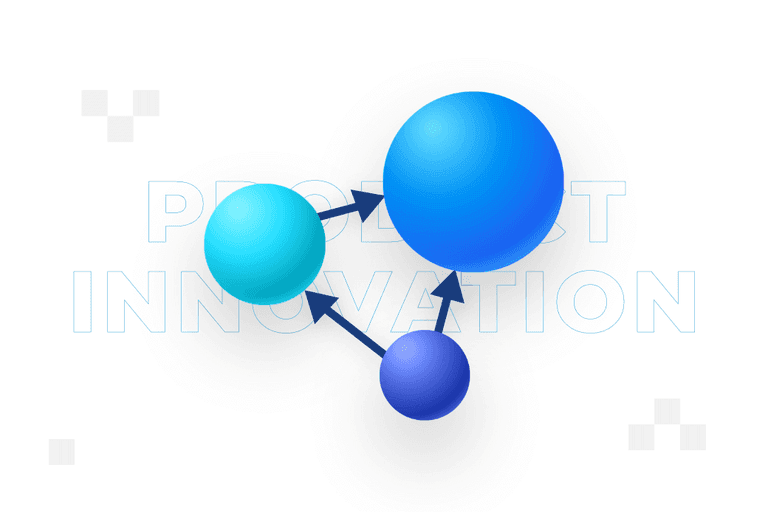
Product innovation – what is it?

Product innovation catalyses growth and enhances competitiveness, and the introduction of improved or entirely new products to the market is a driver of progress in today’s businesses.
From this article you will learn:
- What is product innovation?
- What are the types of product innovation?
- What does the product innovation process look like?
- What are examples of well-known product innovations?
- How do you measure product innovation?
- What can be gained from product innovation?
Product innovation – definition
Product innovation refers to the introduction of new products or product improvements to the market. This process involves not only the application of new technologies or significant improvements, but also offering solutions that are more attractive to consumers through changes in the functionality, usability, performance or quality of the product offered. Product innovations are created both by mature organisations and by startups, focusing only on a particular product or service. In terms of technology, their planning and implementation is usually handled by the Chief Technology Officer (CTO).
Product innovation is the process of developing and marketing new products or significant improvements to existing products to better meet consumer needs or open up new market opportunities.
Definition of product innovation
At the heart of product innovation is the value delivered to customers. By introducing innovations that improve quality of life, increase productivity, reduce costs or make it easier to use, companies create products that meet existing or new customer needs. This often requires intensive research and development activities, which can lead to the discovery of new materials, technologies or production methods.
Product innovation can also change market dynamics – new products can create new market segments, replace old ones or change the way consumers use certain goods and services. At the same time, it carries high risks and requires significant financial and organisational investment.
Types of product innovation
Product innovations can be classified in different ways depending on the nature of the changes they introduce:
- Incremental innovations are incremental improvements to existing products. Often these are small modifications that may consist of quality improvements, additional features or cosmetic changes in design. They help a company maintain or slightly improve its position in the market, but do not drastically change its commercial offering.
- Radical innovations introduce completely new products, often based on new technologies or significant discoveries. They have the potential to create new markets or significantly remodel existing sectors, and for consumers can mean new ways of meeting their needs.
- Architectural innovation occurs when existing technologies or components are regrouped to create a new design or system. While the individual parts may be familiar, their new configurations may provide new value or functionality.
- Modular innovation involves changes to individual product modules, which may include the introduction of new technologies or components into existing systems. This affects the performance of the product, but does not fundamentally change its overall architecture.
- Disruptive innovations are innovations that initially often offer lower performance compared to the existing market standard, but at a lower price or with other new benefits. Over time, the quality of these products increases, changing existing market dynamics and displacing established products or companies.
The product innovation process
The product innovation process starts with idea generation, known as ideation – this is when different concepts for new products are created, collected and selected. Sources of ideas can range from market research to internal brainstorming. Each idea is then assessed in terms of its market potential, technical feasibility and fit with the company’s strategic goals. After selection, the selected concepts are developed and tested, allowing a better understanding of their capabilities and the expectations of potential users.
In parallel, a business strategy for the new product should be developed. Among other things, it should define the market segment, include a pricing and marketing strategy and sales forecasts. This allows you to understand how the product will fit into the wider context of the market and the company’s strategy. You can then move on to design and prototyping – this is when ideas are transformed into tangible models that can be tested, refined and problems identified and solved before the product is launched.
Once a prototype has been created, the product undergoes rigorous testing to check that it meets all standards and expectations – this is necessary to confirm that it is ready for the market. Only after successful testing does the product move beyond the company’s boundaries and into the hands of consumers, requiring coordinated production, marketing, online sales, desktop sales and distribution, as well as after-sales support. After the launch, the performance of the product needs to be continuously monitored, feedback from customers needs to be gathered and problems that arise need to be addressed.
Examples of product innovation
Some product innovations have transformed not only their industry, but also influenced wider social or economic phenomena. Some of the most successful and well-known innovations include:
- When Apple introduced the iPhone in 2007, it revolutionised the mobile phone and communications market. The device combined the functions of a phone, web browser and music player with an intuitive touchscreen interface. the iPhone was an innovation that defined a new product category – smartphones – and led to an entire ecosystem of mobile applications.
- 3D printing technology revolutionised manufacturing, making it possible to create 3D prototypes and finished products from a variety of materials. It has significantly impacted industries such as manufacturing, medicine, fashion and construction and has led to a reduction in material waste, shorter production times and product personalisation.
- Tesla Motors has helped to change the perception of electric cars, showing that they can compete with internal combustion engine vehicles in terms of performance and style. Through innovations in battery and powertrain technology, Tesla has accelerated the global adoption of electric vehicles and contributed to the development of charging infrastructure.
- The Kindle e-book reader, introduced by Amazon, revolutionised the way people read books. It allowed hundreds of titles to be stored in one portable device and played a key role in promoting e-books, influencing the entire publishing industry.
- Impossible Foods introduced the Impossible Burger, a product that mimics the taste, texture and culinary qualities of meat using only plant-based ingredients. It was developed in response to growing consumer interest in a healthy diet, environmental concerns and animal ethics.
Measuring product innovation
Measuring product innovation allows companies to understand what value their investment in new products brings. It covers various aspects, from financial to social, and should start very early in the innovation process. From the moment of ideation, companies can measure the time it takes to generate new ideas, as well as their quantity and quality, which can indicate the effectiveness of internal creative processes. As product development progresses, organisations focus on indicators such as time to market and R&D costs – these show the efficiency of the innovation process and can be early signals of potential problems or delays.
One of the most important aspects of measurement is assessing the market acceptance of a new product. Here, indicators such as sales versus forecasts, speed of market adoption or customer feedback and reviews are crucial. These not only indicate whether the product meets customer expectations, but also allow to react quickly to problems and adapt the marketing or product strategy.
Once a product is launched, companies must continue to monitor its performance. Measuring the return on investment (ROI) of an innovation, analysing the product’s market share relative to the competition, and the profitability of the product all determine the continued success and profitability of an innovation. It is also worth noting the impact of the product beyond the financial sphere – companies are increasingly considering the environmental, social and governance aspects of their innovations, seeking to understand how new products contribute to sustainability and corporate social responsibility.
Benefits of product innovation
Through product innovation, companies can increase their competitiveness in the market. By introducing new or improved products that better meet consumers’ needs, companies can differentiate themselves from their competitors and gain an edge, often leading to greater market share.
Product innovation also often gives access to new market segments or creates entirely new markets – an example is the development of products based on new technologies that open up entirely new categories, offering consumers solutions they could not even dream of before. Furthermore, innovation can lead to increased efficiency and profitability. New products can use resources more efficiently or reduce production costs, which can ultimately lead to improvements in your company’s financial capacity and investment potential.
From a consumer perspective, product innovation improves quality of life, and new and improved products can offer better solutions, increase convenience and even open doors to new experiences and ways of interacting with the world. They can also have a positive impact on the environment and society. For example, products that improve health, education or communication can contribute to social development on a wider scale.
FAQ
Contact form
Develop your brand
Rate content:
You may be interested in:




